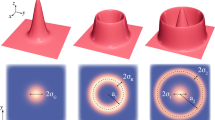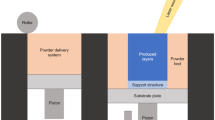Abstract
Keyhole laser welding is widely used as an industrial joining method in recent years, but it is not quantitatively understood due to its high complexity. This paper aims to provide a computational platform to quantitatively predict the thermal history of various locations such as HAZ and WM in the welded parts. The model characterizes the absorbed laser power in the keyhole wall at different depths by applying emission theory of light. Bremsstrahlung reflection, Fresnel absorption coefficient and multiple reflection, obtained from a volumetric heat flux distribution, are used to calculate using the absorbed laser beam density in the butt joint of nickel-based super alloy Inconel 625 to AISI 316L. The simulation results show that the model predicts the thermal history in various locations in good agreement with experimental results. The presented model provides a volumetric model to simulate the heat flux profile using various Fresnel absorption coefficients over the sample depth that captures the actual operation conditions.










Similar content being viewed by others
References
Lingenfelter A (1989) Welding of Inconel alloy 718: a historical overview. In: Loria EA (ed) Superalloy 718: metallurgy and applications. The Minerals, Metals and Materials Society, pp 673–683
Radavich JF (1989) The physical metallurgy of cast and wrought alloy 718 In: Lopia EA (ed) Superalloy 718: metallurgy and applications. The Minerals, Metals and Materials Society, pp 229–240
Salonitis K, Drougas D (2010) Chryssolouris G, finite element modeling of penetration laser welding of sandwich materials. J Phys Procedia 5:327–335
Tan W, Bailey NS, Shin YC (2013) Investigation of keyhole plume and molten pool based on a three-dimensional dynamic model with sharp interface formulation. J Phys D Appl Phys 46:055501
Pang S, Chen L, Zhou J, Yin Y, Chen T (2011) A three-dimensional sharp interface model for self-consistent keyhole and weld pool dynamics in deep penetration laser welding. J Phys D Appl Phys 4(4):025301
Vänskä M, Abt F, Weber R, Salminena A, Graf T (2013) Effects of welding parameters on to keyhole geometry for partial penetration laser welding. J. Phys Procedia 41:199–208
Naffakh H, Shamanian M, Ashrafizadeh F (2009) Dissimilar welding of AISI 310 austenitic stainless steel to nickel-based alloy Inconel 657. J Mater Process Technol 209:3628–3639
Baghjari SH, AkbariMousavi SAA (2014) Experimental investigation on dissimilar pulsed Nd:YAG laser welding of AISI 420 stainless steel to kovar alloy. J Mater Des 57:128–134
Al-Kazzaz H, Medraj M, Cao X, Jahazi M (2008) Nd:YAG, laser welding of aerospace grade ZE41A magnesium alloy Modeling and experimental investigations. J. Mater Chem Phys 109:61–76
Zhang YM, Liu YC (2007) Control of dynamic keyhole welding process. J Autom 43:876–884
Fujinaga S, Takenaka H, Narikiyo T, Katayama S, Matsunawa A (2000) Direct observation of keyhole behavior during pulse modulated high-power Nd:YAG laser irradiation. J Phys D Appl Phys 33:492–497
Volpp J, Vollertsen F (2013) Analytical modeling of the keyhole including multiple reflections for analysis of the influence of different laser intensity distributions on keyhole geometry. J. Phys Procedia 41:453–461
Ramkumar KD, Patel SD, Parveen SS, Choudhury DJ, Prabaharan P, Arivazhagan N, Anthony Xavior M (2014) Influence of filler metals and welding techniques on the structure property relationships of Inconel 718 and AISI 316L dissimilar weldments. J Mater Des. doi:10.1016/j.matdes.2014.05.019
Kaplan A (1994) A model of deep penetration laser welding based on calculation of the keyhole profile. J Phys D Appl Phys 27:1805–1814
Dowden J, Kapadia P, Postacioglu N (1989) An analysis of the laser-plasma interaction in laser keyhole welding. J Phys D Appl Phys 22(6):741–749
Solana P, Negro G (1997) A study of the effect of multiple reflections on the shape of the keyhole of the keyhole in the laser processing of materials. J Phys D Appl Phys 30:3216–3222
Bachmann M, Avilov V, Gumenyuk A, Rethmeier M (2014) Experimental and numerical investigation of an electromagnetic weld pool control for laser beam welding. J. Phys Procedia 56:515–524
Jin X, Berger P, Graf T (2006) Multiple reflections and Fresnel absorption in an actual 3D keyhole during deep penetration laser welding. J Phys D Appl Phys 39(21):4703–4712
Jin X, Li L, Zhang Y (2002) A study on Fresnel absorption and reflections in the keyhole in deep penetration laser welding. J Phys D Appl Phys 35:2304–2310
Punkari A, Weckman DC, Kerr HW (2003) Effects of magnesium content on dual beam Nd:YAG laser welding of Al–Mg alloys. J Sci Technol Weld Join 8(4):269–281
Lampa C, Kaplan AF, Powell J, Magnusson C (1997) An analytical thermodynamic model of laser welding. J Phys D Appl Phys 30(9):1293–1299
Al-Kazzaz H, Medraj M, Cao X, Xiao M, Jahazi M (2006) Effect of laser power and joint gap on weld quality of aerospace grade ZE41A-T5 magnesium alloy using Nd:YAG laser. In: Proceedings of the international symposium on magnesium, J Technology in the Global Age, p 503–518
Dausinger F, Rapp J, Beck M, Faisst F, Hack R, Hugel H (1996) Welding of aluminum: a challenging opportunity for laser technology. J Laser Appl 8(6):285–290
Swift-Hook DT, Gick AEF (1973) Penetration welding with lasers. J. Weld 52(11):492–499
Author information
Authors and Affiliations
Corresponding author
Additional information
Technical Editor: Alexandre Mendes Abrao.
Rights and permissions
About this article
Cite this article
Ebrahimi, A.N., Arab, N.B.M. & Gollo, M.H. Thermal analysis of laser beam welding of nickel-based super alloy Inconel 625 to AISI 316L, using Gaussian optics theory in keyhole. J Braz. Soc. Mech. Sci. Eng. 38, 1199–1206 (2016). https://doi.org/10.1007/s40430-015-0422-5
Received:
Accepted:
Published:
Issue Date:
DOI: https://doi.org/10.1007/s40430-015-0422-5




